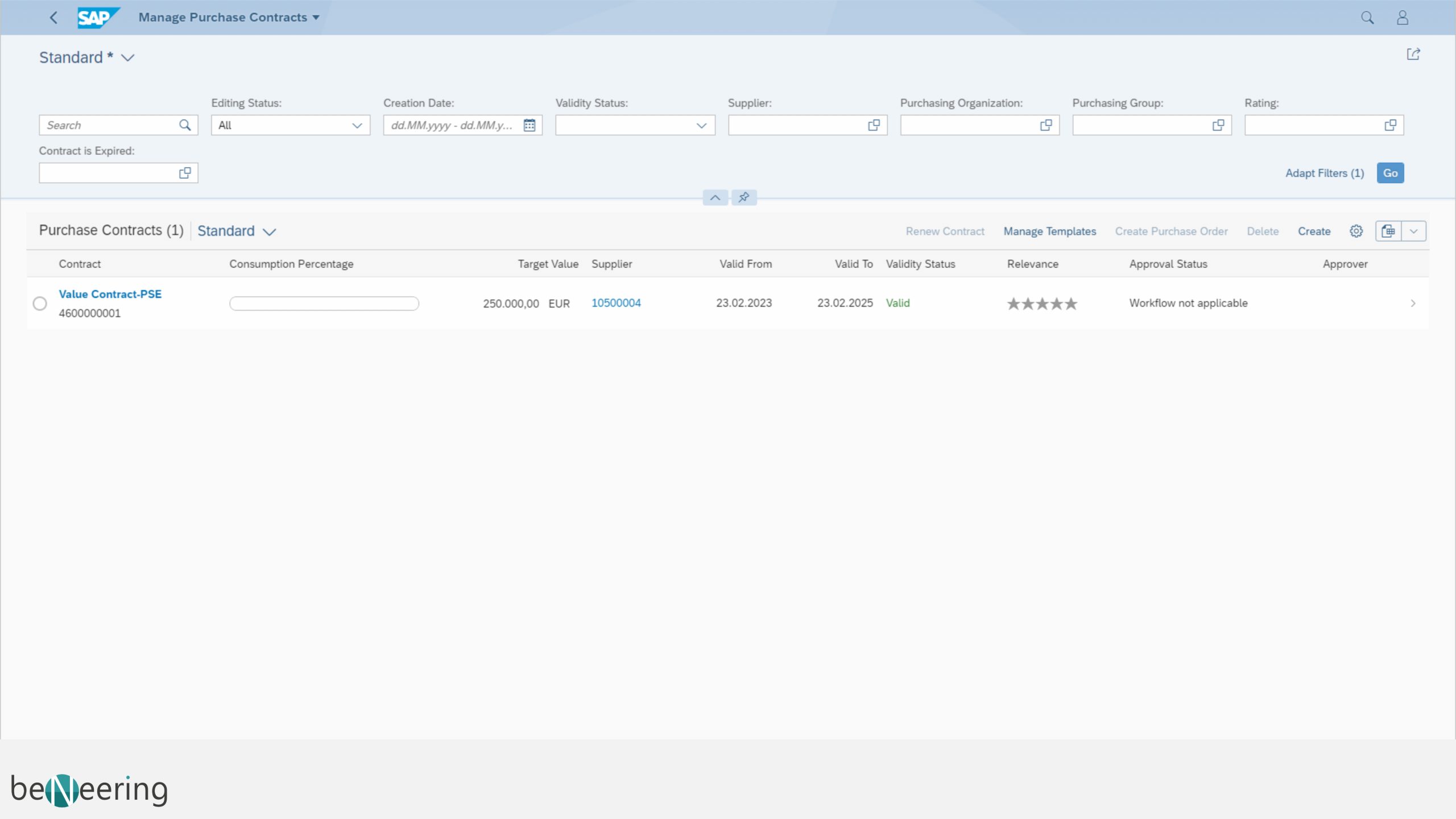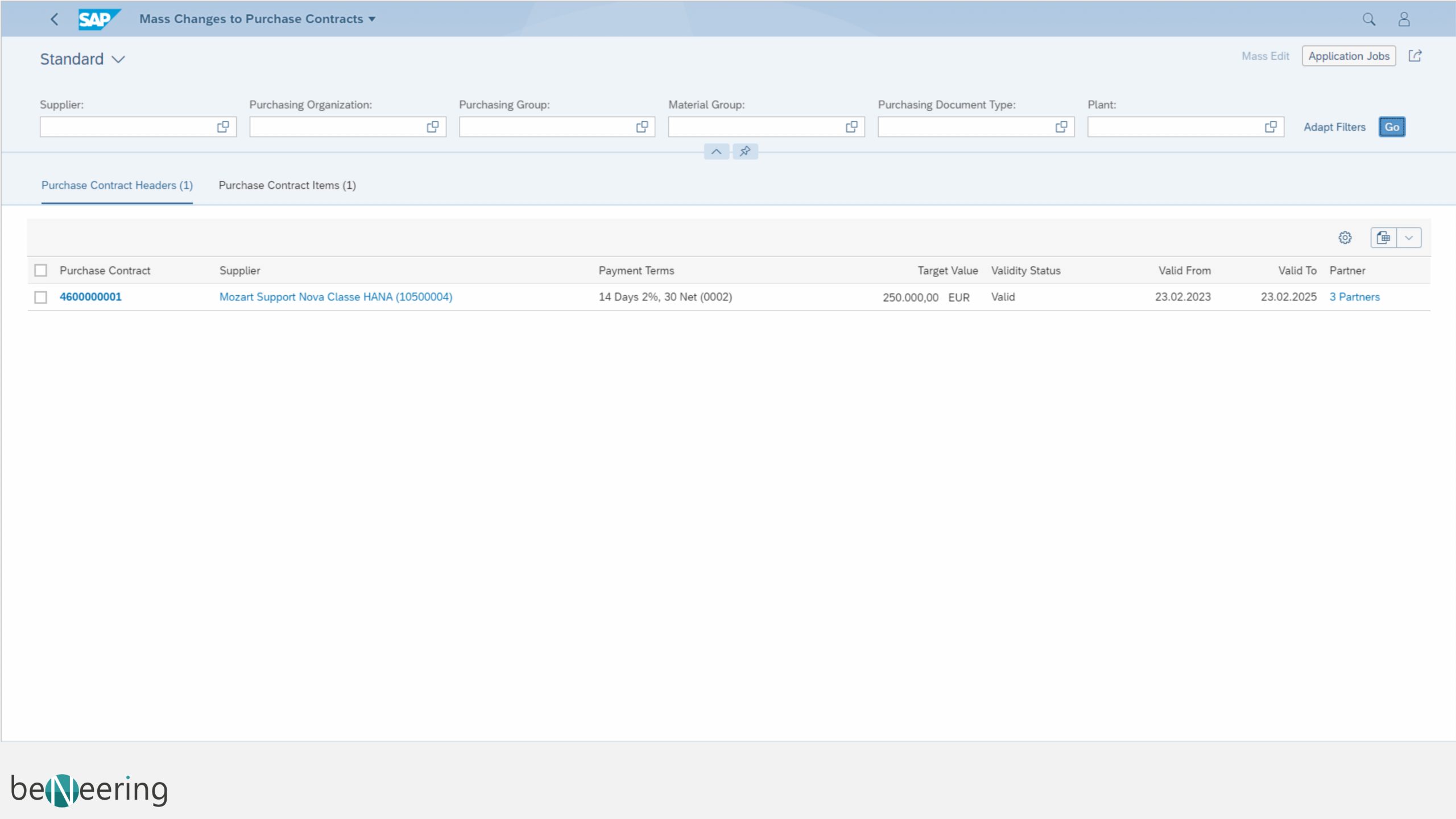Even a purchase order with a confirmation of order is a contract, as there is even a written declaration of intent on both sides. For companies that already have SAP in use and have switched to or intend to switch to S/4HANA, it makes a lot of sense to map and manage further contracts in the same system. In addition to framework contracts (value and quantity contracts as well as call-off orders) and delivery schedules, other legal contracts such as confidentiality agreements, etc., can also be managed with the contract management of S/4HANA (Contract Management & Assembly). In terms of reporting and notifications when contracts expire, SAP has also gained more functionality here.
FRAMEWORK CONTRACTS IN S/4HANA
Like regular purchase orders, framework contracts consist of header and item data. SAP distinguishes between quantity contract, value contract, and call-off order.
QUANTITY CONTRACT
In a quantity contract, agreed quantities, prices, and conditions for materials and services are defined for the respective supplier. This allows the purchaser to send multiple call-off orders to the supplier until the sum of the call-off values reaches the agreed quantity limit in the framework contract. Especially in times when supply security is paramount, this type of framework contract should be chosen.
VALUE CONTRACT
Value contracts should be used especially when the total value of all contract call-offs should not exceed a certain amount. The contract is considered fulfilled when the agreed value is reached as a result of contract call-offs.
CALL-OFF ORDER
With the SAP GUI transaction ME21N, it is possible to create a call-off order simply as an order with reference to a contract. With this transaction, the system will pull all information from the contract after you have entered the contract number in the contract field in the item data. The system expects input of quantities and delivery date. After the call-off order has been created, it is possible to edit or display it with transactions ME22N or ME23N.
CREATING AND MANAGING FRAMEWORK CONTRACTS
Framework contracts can be created either directly by manually entering all data or by reference to the purchase requisition (“BANF”), a request for quotation (“RFQ”), or another framework contract. Transaction ME31K is used to create the framework contract, which can also be accessed via the SAP Fiori Launchpad. With the introduction of SAP Fiori apps for SAP S/4HANA, the app “Manage Purchasing Contracts” can be used.
BULK Changes
When changing individual fields of framework contracts, it makes a lot of sense to use the mass change function instead of manually changing each contract. With this app, it is also possible to export a list of framework contracts in tabular form.
REPORTING AND NOTIFICATIONS
In the area of contract management reporting, many innovations have been achieved in S/4HANA. This is due on the one hand to SAP S/4HANA’s so-called “In-Memory” technology, and on the other hand to the SAP Fiori User Interface (UI). The following table provides an overview of the respective Fiori apps:
| Fiori App | Description | Output | Benefit | Remark |
|---|---|---|---|---|
| Unused contracts | Displays the target and approved values for contracts that were not used in the last 365 days. | The output can be displayed in table or chart format by supplier, purchasing organization, purchaser group, etc. | Helps to avoid "invisible spending" (spending without benefit) in procurement and business units. | Drill-down to document level is possible. |
| Procurement volume not covered by frame contracts | Shows the procurement volume that is not covered by frame contracts. | The output can be displayed in table or chart format by supplier, purchasing organization, purchaser group, etc. | Closing gaps in contracts increases efficiency and reduces costs. | Analysis of trends by category or supplier is possible. |
| Contract leakage (contract compliance) | Shows the procurement volume of orders that do not refer to the existing frame contract, but could. | An output and drill down by supplier, purchasing organization, purchaser group is possible by clicking on the bar in the column chart and selecting the respective navigation option. | Increasing contract compliance increases efficiency and reduces costs. | List display of the documents that contribute to the output value. |
| Procurement contract positions by account assignment | Shows the contract positions grouped by cost center with filters for the procurement contract, cost center, order, PSP element, asset, etc. | By clicking on a cost center in the output result, details such as material, supplier, account assignment, net value, etc. can be viewed and analyzed. | Increases transparency, especially for cost center managers and project managers or project controllers. | Drill-down to the respective procurement document is possible. |
| Monitoring procurement contract positions | Initially shows a chart with the aggregated contract volume per material or merchandise group. | The total frame contract value and the called-off value are shown in two different bars in this chart. When clicking on a bar, the corresponding frame contract positions are displayed in a list. | Increases transparency and control options in procurement. | Filter option of contract positions by currency, frame contract, merchandise or material group, material, supplier, cost center, etc. Drill-down to document level is possible. |
| Contract expiration | Identifies frame contracts that expire at certain deadlines. | The app displays the expiring contract, target value, and approved value. The output can be displayed in table or chart format by supplier, purchaser group, purchasing organization, procurement category, or merchandise or material group. | Supports timely action by procurement when contracts expire (e.g. contract extension, renegotiation, new tendering). | Various filtering options, e.g. by frame contract, validity period, supplier, etc. |
DELIVERY SCHEDULES IN S/4HANA
Delivery schedules are another form of framework contracts. As the name suggests, delivery schedules are used to procure a certain quantity according to a specific plan within a specified period. The agreed delivery schedules include quantities and delivery times. Conditions can be maintained at the header level, making them applicable to all items. Alternatively, conditions can be maintained separately at the item level. Additionally, accounting information can also be stored in the items to ensure the control of these procurement documents.
ADVANTAGES OF DELIVERY SCHEDULES
The following advantages are associated with the use of delivery schedules in S/4HANA:
- A delivery schedule can replace a large number of individual purchase orders and releases
- Lead times, administrative efforts, and inventory levels can be reduced
- Production processes can be designed according to the “just-in-time” principle
- Better planning and resource utilization of suppliers through lower delivery times with smaller quantities over a longer period of time
TYPES OF DELIVERY SCHEDULES
The various types of delivery schedules are determined in customizing by document types. The three standard document types are now explained in detail.
DELIVERY SCHEDULE WITH CALL-OFF DOCUMENTATION
The document type LPA is used for this delivery schedule. In this case, the individual delivery schedule divisions are considered internal when creating the delivery schedule and are not sent to the suppliers. This allows for easy changes, leading to high flexibility. Only when a call-off of the delivery schedule is made, the information from the delivery schedule divisions is sent to the supplier. Two types of call-offs are available with this delivery schedule type LPA:
The forecast delivery schedule (FRC) and the just-in-time delivery schedule.
DELIVERY SCHEDULE WITHOUT CALL-OFF DOCUMENTATION
For this type of delivery schedule, the document type LP applies. The created delivery schedule divisions are official and are sent to the supplier as soon as they are created. No call-off documentation is provided.
STOCK TRANSFER DELIVERY SCHEDULE
If material transfers between plants within a company occur frequently and regularly, it makes sense to create a transfer delivery schedule. The corresponding document type is LU, and the position type is U.
CREATING AND MANAGING DELIVERY SCHEDULES
Delivery schedules can be manually created or used as templates with other purchasing documents such as purchase requisitions, inquiries, other delivery schedules, or contracts. The Fiori app “Manage Delivery Schedules” offers the possibility to search and filter delivery schedules by purchasing organization, contract type, supplier, material, status, validity period, etc. It allows the user to view, copy, edit, create, and delete delivery schedules. In addition, the delivery schedule divisions can be maintained here. The app also displays delivery schedules that are expiring soon and allows the user to renew them with a simple click on the corresponding button.




